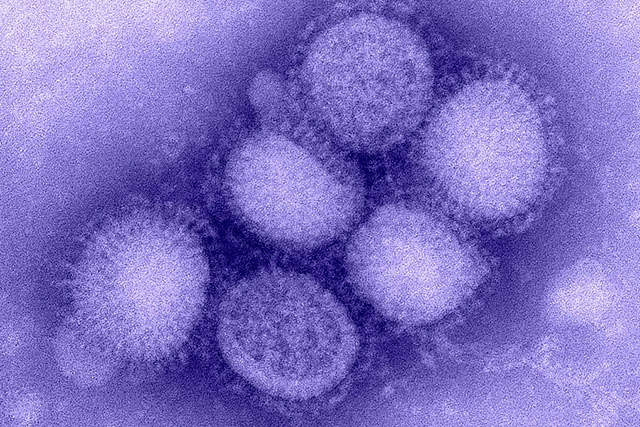Influenza: the evolution of the virus and universal vaccine
13 Dec 2016
The biologist Dr. Doping speaks about the occurrence of epidemics of influenza, the virus the causes of evolution, the search for a universal vaccine and the risk of the swine flu strain (H1N1).

People are dying because of the evolution. About 30% of deaths occurring on the globe can be attributed to the evolution of simple organisms, starting with infectious agents that attack us all the time, - viruses, fungi and bacteria - and ending with our own body cells, changes that sometimes lead to cancer.
One of the worst infections - the most common flu. Every year it takes the lives of about 250 thousand, and in some years more. The biggest known outbreaks of influenza - the famous Spanish flu of 1918, which destroyed a few percent of the world's population.
The strain of the influenza virus
As with any biological entity, each virus continually changes occurring as a result of mutations in its genome. The influenza virus - one of relatively fast-changing virus. One reason - that its genetic information is encoded RNA molecules, rather than DNA, for example, our genome; RNA - a molecule mutate easily. Another reason - a virus acts continuously selection: many of the mutations occurring in its genome are "useful" for him, allowing to efficiently transmit, for example, among people.
Due to the properties of accumulating mutations of influenza virus changes gradually. The most notable result of mutations for us - it changes the antigenic properties of the virus, that is, the ability of the cells of our immune system to recognize the strain. Such incremental changes are called antigenic drift. Now it is believed that most of the antigenic drift is in the tropics, where the flu is not pronounced seasonal epidemics and is kept at the same level in the human population all year round. But in the northern and southern hemispheres - respectively, in December-March and June-October - every year there are new epidemics. WHO usually recommend a new vaccine composition for six months before the vaccine is really starting to be used - for the reason that its production cycle is quite long.
The evolution of the influenza virus
In addition to the gradual antigenic drift, the evolution of the influenza virus is characterized as antigenic shifts - radical changes in virus characteristics that are commonly associated with reassortment. In the influenza virus genome is recorded on eight separate segments, a little reminiscent of the human chromosomes. When the host cell is infected simultaneously by two viral particles of two different strains, these segments are mixed up, and it may be a new virus particle with new properties, consisting partly of the segments of the parent strain, and partly - of the other. Such reassortant strains often differ in their properties from the parent strains and sometimes lead to large epidemics. All the major pandemics of the twentieth century, about which we know - a pandemic 50-70-ies, as well as, most likely, a Spaniard in 1918 - were caused, apparently, such reassortment when the strains coming from different types of organisms, such as birds, pigs, horses, mixed and allowed something new with which the human immune system has not previously encountered.
Prediction of virus mutation
Whether influenza evolution is predictable? In the short term – yes, it is. Recent scientific studies show that you can kind of predict the future evolution of the virus, if you know about his previous evolution. It can be as evolutionists like to build an evolutionary tree. And at the usual influenza A virus, it has a very characteristic form: a separate trunk, which runs stubby twigs. When you see a tree of such a form, you can almost always be sure that you are dealing with a pathogen. There is one single line that is evolutionarily successful, and it is characterized by rapid change, so that the immune system of collective humanity is necessary all the time to shoot at a moving target. From her other lines branch off, which eventually die out. However, some variety there are permanently.
To at least roughly understand looking at the diversity of this year, some of the strains observed in the current year will give the epidemic the following year, it is necessary to look at what the mutations are different strains from each other. If the virus has accumulated a large number of mutations in its epitopes, that is, in places of their surface (sticking out) proteins that are "visible" to the immune system, it is likely he will be invisible to the immune system, and therefore is likely effective. Conversely, if he had any mutations in internal genes, these mutations are likely to be harmful - they make the virus less fit, and these lines will become extinct. It is possible to construct a mathematical model, based on the number of mutations in the epitopes and other places, which predicts future evolutionary success of the virus. In addition, it is possible to study how the virus strain has been evolutionarily successful so far, and extrapolate it into the future. Such approaches have limitations; for example, they do not yet take into account the interaction between genes. At 11 genes of the virus of influenza, and they all interact with each other in complex ways. In drawing up this type of forecast considerations is usually omitted, although different groups, including ours, have shown that they are really important. However, in the short term, they are important.
Predicting the long-term evolution of the virus, including antigenic shifts, much more difficult. At least for this we must learn to understand what kind of strains currently observed will reassortant, which can lead to the following serious epidemic. Such predictions, we do not know how, because there are so many confounding factors. It is important to look to anyone else interacts people, it is important to try to predict exactly which strains are more likely to easily "learn" from person to person.
How there are epidemics
Epidemics can cause strains present in the population before. For example, the current epidemic of 2016 caused by the influenza virus, first seen in humans in 2009. Usually, however, the most serious epidemics caused by strains, new to humans. To happen this epidemic to happen several events. In some animal species, interacts with people, it should be a variant of a pathogen that can infect humans; This option should be transmitted to humans; Finally, as a rule, he must acquire additional mutations that allow it to efficiently infect humans. The probability of each of these events is very difficult to estimate, so in advance to predict the epidemic, we can not.
Swine Flu H1N1
This year, about two-thirds of all cases of influenza caused by pandemic H1N1 strain of 2009, known under the name "swine." This virus was really seems to get a person from pigs, but the same is true for many other viruses: transmission from pigs - it is quite a frequent mechanism for the emergence of new strains in humans. A striking feature of the H1N1 / 09 - it is a very interesting origin: some of its segments came from bird flu, some - of swine, some - of ordinary human H3N2, which has so far caused all infections. A melting pot where all these segments have met each other, became pigs. It is now clear that the mortality rate from H1N1 / 09 is approximately the same as that of ordinary flu, we hurt each year before (although there are nuances). In fact, this year the H1N1 / 09 was the seasonal flu, and it is possible that he will remain with us for many years.
A universal flu vaccine
From the flu there is a fairly effective vaccine. But the problem is that it is always out of date, because every year the virus evolves, changing its antigenic properties and once again becoming a stranger to our immune system. The vaccine is a result have to be constantly updated. Each year, experts from the World Health Organization (WHO) recommend that all producers of the new composition of the so-called trivalent vaccine, listing the three strains that should be incorporated into it. Best of all trivalent vaccine protects it from them. Although, of course, there is a cross protection, and from strains antigenically similar properties to these three strains, it will protect well, too. Nevertheless vaccinated against the flu every year, we recommend, and rightly so. this year's trivalent vaccine includes the H1N1 / 09, so that those who are vaccinated in the autumn, is now likely to win. The vaccination does not guarantee that you will not get sick, but reduces the likelihood of this.
To support your immune system - you should buy IRS 19, Cyanocobalamin injection, Actovegin, Ladasten, Bonomarlot.
Predictions of how exactly will the evolution of influenza would be less relevant if we learned how to make a universal vaccine that protects against all strains. While there is a vaccine, although several candidates in clinical trials. The difficulty is that the immune "visible" system are exactly the virus surface proteins (hemagglutinin and neuraminidase) that the virus easily and painlessly for themselves can change. Therefore, vaccination is difficult to explain the immune system, in that it, in fact, it is necessary to aim.
Artificial synthesis of an influenza strain
It has been sensational work of one group from the Netherlands and groups from Japan, where researchers have tried to synthesize hand strain of bird flu, which would be able to be transmitted between mammals. They succeeded. Their work was considered ethically controversial, because they were all afraid that a synthetic strain can "escape" from the laboratory that it is not necessary genes to spread in open access, because somebody is maliciously can be synthesized. However, now we know what properties may have the strain of bird flu that can be transmitted to humans.

 Cart
Cart





